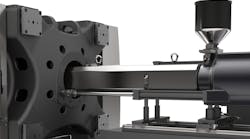Design works best when applied in its widest form. Here are six ways to use design in the industrial sector to create results that go beyond the traditional idea of design as merely an aesthetic exercise.
1. Design for Usability and Safety
Usability, or ergonomics, looks at machines from the point of view of the people who use them. How efficient is it? Is it effective? Is it safe? With so many physical stress factors such as noise, increased danger levels and the challenging environments industrial machines operate in, mistakes can have serious consequences. That’s why designers must always start with the user, an approach known as human-centered design. The better the user’s needs are understood, the safer, the more functional the result.
A clean design with an ordered component distribution creates a safer work environment for the operator. When working for Tederic, the Chinese producer of plastic injection molding machines, the Design Group Italia team spent days in their production facility in Hangzhou City, China observing the operators to really understand how they use the machines. By teaming with Tederic’s R&D team, a clean, minimalist design language with easily accessible HMIs, indicators and inspection areas was developed to best serve the users.
2. Design as Communication
Companies buy industrial machines to perform clear functions. Trustworthiness, credibility and level of innovation of the machinery are key drivers in the purchasing process. Beyond the logo or brand identity, a well-designed machine is the most important vehicle of the brand, bringing considerable competitive advantage and communicating the technological capabilities of the manufacturer.
What the machine design communicates depends on the company. The woodworking machinery producer SCM Group already had a strong brand but wanted to create a new line that would be the reference point for the entire category. The resulting L’Invincibile communicates top-of-the-line quality, technological excellence and exclusivity.
3. Design that Creates Economies of Scale
Designers play a crucial role in optimizing machinery for production and upkeep costs. For the die casting machine producer Idra Group, similar modules were used for multiple types of machines in the product family, which dropped production costs and made replacing parts and keeping product stocks easier.
Industrial designers need to work closely with engineers to facilitate easy and efficient production. And not only with engineers: The Design Group Italia team believes in working in multidisciplinary teams as often as possible. When everything from HMI to logo to colors, materials, finishings and the physical product design is signed off by the same team, including industrial designers, engineers and digital designers, the process results in more than efficiency. Each aspect of the final product will be coordinated, curated, and created faster as one team—not multiple agencies—works on the entire extended solution.
4. Design That Aligns and Integrates
Companies can have complex structures with many stakeholders involved in the decision-making for industrial equipment. Sales, technical officers, leadership and operators all come with different vertical expertise and views. The designer doesn't just shape the machine; he finds a shared direction that connects the dots for the bigger picture to unite marketing for the brand expression and engineering on how it is constructed and produced. When done well, it results in a market offering with innovative technology and immediately perceivable quality.
ABB, for example, had grown through acquisitions to manage a mixed portfolio of products. A powerful design system helped integrate its offering and capitalize on the ABB brand.
5. Design to Make the Most out of Data and Industry 4.0
Rapid developments in technology and digital transformation have brought complex challenges and exciting opportunities to the industrial sector. Now, increasingly complex HMIs allow users to track massive amounts of data not only for operating the machines but also for supervising predictable issues. Designing easy, intuitive and user-friendly dashboards that facilitate the new needs is crucial and incredibly challenging.
Challenged with designing a UX system encompassing hundreds of parameters for the injection molding machine supplier Negri Bossi, the Design Group Italia team’s intuitive design uses multitouch and new touchpads. With the swipe of a finger, operators can control the 11-meter-long machine and its 850-ton press.
6. Design as a Change Maker
Alongside innovation and evolution to the industry, digital transformation has brought a faster-paced, deeply digitally minded culture to a traditionally mechanical context. When working on software, updates and changes can be made with a click of a button, while the lifetime of an industrial machine is counted in decades.
Digital, technical and industrial specialists are all needed to develop futureproof functional solutions. However, it’s people, not technological solutions, who will bring about true transformation. Speaking both traditional and the new digital languages, designers can serve as change agents, translators and facilitators in bringing forth the digital transformation processes in companies.
Contributed by Design Group Italia and authored by Edgardo Angelini, managing director; Andrea Desiato, digital product design director; Martin Franzen, product design director; and Pasquale Cirulli, lead industrial designer.

